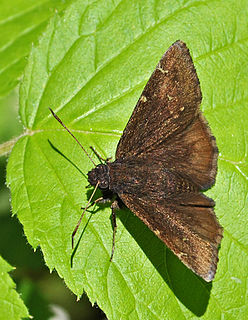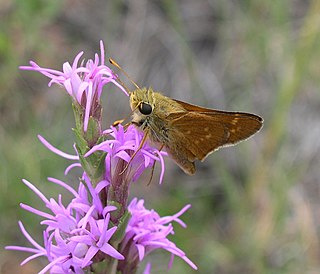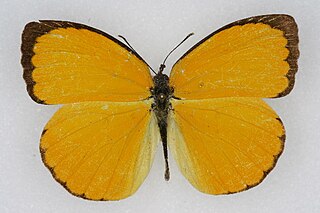
Thorybes pylades, the northern cloudywing, is a butterfly species of the family Hesperiidae.

Thorybes bathyllus, the southern cloudywing, is a North American butterfly in the family Hesperiidae. Southern cloudywings can be difficult to identify because of individual variation and confusing seasonal forms. In the south, where it has two broods per year, two seasonal forms occur. Spring forms are usually lightly marked and resemble confused cloudywings. Summer forms tend to be more boldly marked, by comparison, making identification easier. However, summer confused cloudywings are also strongly patterned, which makes identifying them more difficult. Their rapid flight is very erratic, though it is closer to the ground than in some of its close relatives.

Cyllopsis gemma, the gemmed satyr, is a species of butterfly of the family Nymphalidae. It is found in the southeastern United States and northeastern Mexico.

Thorybes is a genus of skippers in the family Hesperiidae subfamily Eudaminae.

Anthanassa frisia, the Cuban crescentspot, Cuban checkerspot or Cuban crescent, is a butterfly of the family Nymphalidae. Subspecies tulcis is known by the common names pale-banded crescent or Tulcis crescent; it is treated as a species by some authors. The nominate subspecies is found in the West Indies and southern Florida, with strays to northern Florida. Subspecies tulcis is found from Argentina north through Central America and Mexico to southern Texas, strays to west Texas and southern Arizona. Other subspecies are resident to South America.

Wallengrenia egeremet, the northern broken dash , is a butterfly of the family Hesperiidae. It is found in North America from southern Maine and southern Ontario, west across the Great Lakes states to southeastern North Dakota, south to central Florida, the Gulf Coast and south-eastern Texas.

Wallengrenia otho, the southern broken dash or broken dash skipper, is a butterfly of the family Hesperiidae. It was originally described by Smith in 1797. It is found from eastern Texas and the southeastern United States, south through the West Indies and Central America to Argentina. Strays can be found as far north as central Missouri, northern Kentucky and Delaware.
Thorybes confusis, the confused cloudywing, is a butterfly in the family Hesperiidae.

Hesperia leonardus, the Leonard's skipper, is a butterfly of the family Hesperiidae. There are three subspecies. Next to the nominate species, these are the Pawnee skipper, which is found in North America from western Montana and south-eastern Saskatchewan east to Minnesota, south to central Colorado and Kansas. Leonard's skipper ranges from Nova Scotia and Maine west through southern Ontario and the Great Lakes region to Minnesota, south to North Carolina, Louisiana and Missouri and the Pawnee montane skipper is endemic to the South Platte River drainage of Colorado.

Callophrys augustinus, the brown elfin, is butterfly of the family Lycaenidae. It is found from Newfoundland north and west through the northern United States and the prairie provinces to Alaska. To the south it ranges in Appalachian Mountains to northern Georgia and northern Alabama, further south through the western mountains to northern Baja California in Mexico. Subspecies iroides is known as the western elfin.

Euphyes dukesi, or Dukes' skipper, is a butterfly of the family Hesperiidae. It lives in the eastern United States and in a small portion of southern Ontario, Canada, in three distinct populations. Preferred habitats are shaded wetlands, with various species of sedge plants it uses as host plants for its larvae.

Eurema boisduvaliana, commonly known as Boisduval's yellow, is a butterfly in the family Pieridae. It is found from Costa Rica north to Mexico. Rare strays may be found in southern Florida, but it is a regular migrant to south-eastern Arizona, south-western New Mexico, and southern Texas. The habitat consists of subtropical forests and forest edges, scrubs, roadsides and pastures.

Eurema dina, the dina yellow, is a butterfly in the family Pieridae. The species was first described by Felipe Poey in 1832. It is found from Panama north to southern Florida. The species is regularly recorded from southern Texas and south-eastern Arizona. The habitat consists of forest edges, brushy fields and open forest.

Anthanassa texana, the Texan crescentspot, is a species of butterfly in the family Nymphalidae. It is found from Guatemala north through Mexico to southern California, east across the southern United States to northern Florida, Georgia and South Carolina. Strays may be found up to Arkansas, Missouri, Illinois, South Dakota, and central Nevada. The habitat consists of deserts, dry gulches, open areas, streamsides, road edges, and city parks.

Hemiargus ceraunus, the Ceraunus blue, is a butterfly in the family Lycaenidae. The species was first described by Johan Christian Fabricius in 1793. It is found in the southwestern United States, southern Texas, Florida and the Florida Keys south through the West Indies, Mexico and Central America to South America. Strays may be found in North Carolina, Missouri, Kansas and Nevada. The habitat consists of open woodland, desert scrub, dunes, pastures, road edges and vacant lots.
Thorybes diversus, the western cloudywing, is a butterfly of the Hesperiidae (skipper) family. It is found in the western North America. The range extends along western slopes of the Sierra Nevada and Cascade Mountain ranges, from southern Oregon to Mariposa County. The habitat consists of small openings in coniferous forests.















